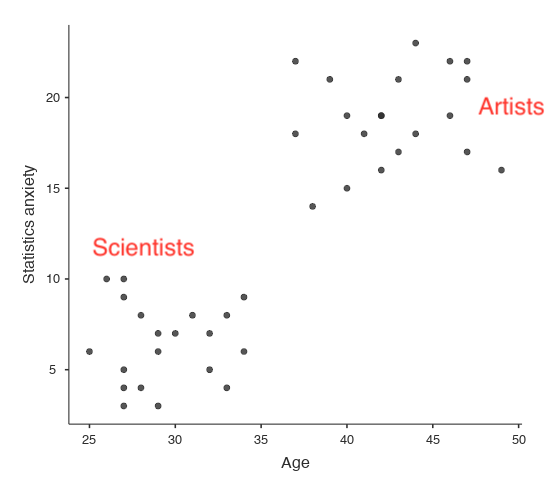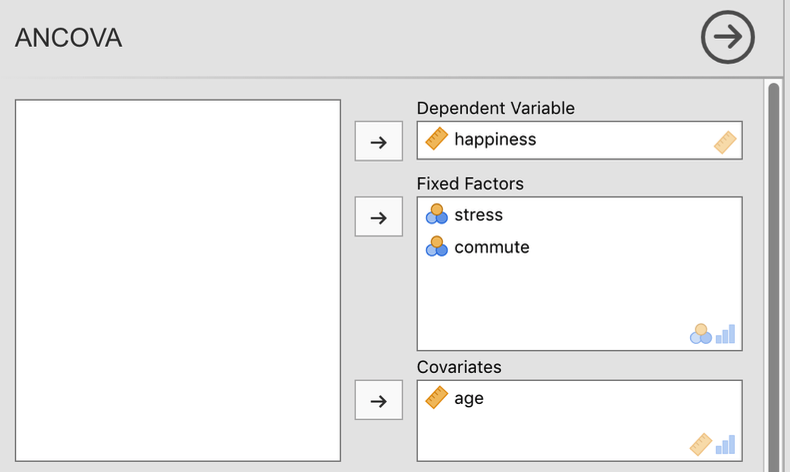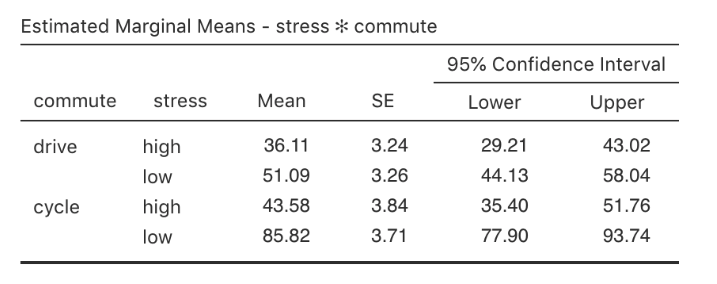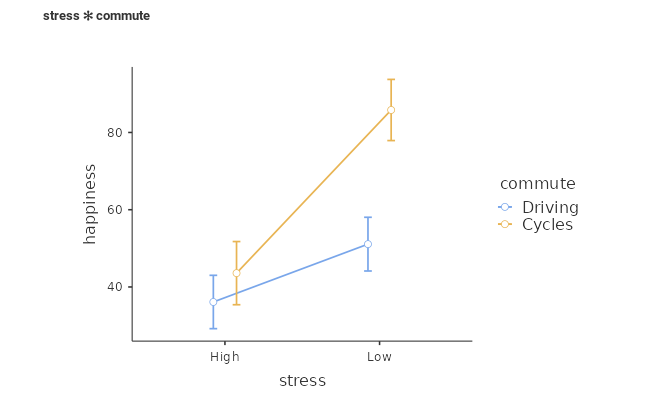Section author: Danielle J. Navarro and David R. Foxcroft
Analysis of Covariance (ANCOVA)¶
A variation in ANOVA is when you have an additional continuous variable
that you think might be related to the dependent variable. This
additional variable can be added to the analysis as a covariate, in the aptly
named analysis of covariance (ANCOVA).
In ANCOVA the values of the dependent variable are “adjusted” for the influence
of the covariate, and then the “adjusted” score means are tested between groups
in the usual way. This technique can increase the precision of an
experiment, and therefore provide a more “powerful” test of the equality of
group means in the dependent variable. How does ANCOVA do this? Well, although
the covariate itself is typically not of any experimental interest, adjustment
for the covariate can decrease the estimate of experimental error and thus, by
reducing error variance, precision is increased. This means that an inappropriate
failure to reject the null hypothesis (false negative or type II error) is less
likely.
Despite this advantage, ANCOVA runs the risk of undoing real differences
between groups , and this should be avoided. Look at
Fig. 154, for example, which shows a plot of Statistics
anxiety against age and shows two distinct groups – students who have either
an Arts or Science background or preference. ANCOVA with age as a covariate
might lead to the conclusion that statistics anxiety does not differ in the two
groups. Would this conclusion be reasonable – probably not because the ages of
the two groups do not overlap and analysis of variance has essentially
“extrapolated into a region with no data” (Everitt, 1996).

Fig. 154 Plot of Statistics anxiety against age for two distinct groups
Clearly, careful thought needs to be given to an analysis of covariance with distinct groups. This applies to both one-way and factorial designs, as ANCOVA can be used with both.
Running ANCOVA in jamovi¶
A health psychologist was interested in the effect of routine cycling and
stress on happiness levels, with age as a covariate. Open the ancova data set
in jamovi and then, to undertake an ANCOVA, select Analyses → ANOVA →
ANCOVA to open the ANCOVA analysis window (Fig. 155). Highlight
the dependent variable happiness and transfer it into the
Dependent Variable text box. Highlight the independent variables stress
and
commute and transfer them into the
Fixed Factors
text box. Highlight the covariate age and transfer it into the
Covariates text box. Then, click on Estimated Marginal Means to bring
up the plots and tables options.

Fig. 155 Options panel showing the variable boxes to assign the Dependent
Variable, Fixed Factors and the Covariates for the ANCOVA in
jamovi
An ANCOVA table showing Tests of Between-Subjects Effects is produced in the
jamovi results panel (Fig. 156). The F-value for the covariate
age is significant at p = 0.023, suggesting that age is an important
predictor of the dependent variable, happiness. When we look at the estimated
marginal mean scores (Fig. 157), adjustments have been made
(compared to an analysis without the covariate) because of the inclusion of the
covariate age in this ANCOVA. A plot (Fig. 158) is a good way of
visualising and interpreting the significant effects.

Fig. 156 jamovi ANCOVA output for happiness as a function of stress and commuting method, with age as a covariate

Fig. 157 Table with the Estimated Marginal means within the ANCOVA: Shown are the mean happiness level as a function of stress and commuting method (adjusted for the covariate age) with 95% confidence intervals
The F-value for the main effect stress (52.61) has an associated
probability of p < 0.001. The F-value for the main effect commute (42.33)
has an associated probability of p < 0.001. Since both of these are less than
the probability that is typically used to decide if a statistical result is
significant (p < 0.05) we can conclude that there was a significant main
effect of stress (F(1,15) = 52.61, p < 0.001) and a significant main
effect of commuting method (F(1,15) = 42.33, p < 0.001). A significant
interaction between stress and commuting method was also found (F(1,15) =
14.15, p = 0.002).
In Fig. 158 we can see the adjusted, marginal, mean happiness scores when age is a covariate in an ANCOVA. In this analysis there is a significant interaction effect, whereby people with low stress who cycle to work are happier than people with low stress who drive and people with high stress whether they cycle or drive to work. There is also a significant main effect of stress – people with low stress are happier than those with high stress. And there is also a significant main effect of commuting behaviour – people who cycle are happier, on average, than those who drive to work.

Fig. 158 Plot with the Estimated Marginal means within the ANCOVA: Shown are the mean happiness level as a function of stress and commuting method
One thing to be aware of is that, if you are thinking of including a covariate
in your ANOVA, there is an additional assumption: the relationship between the
covariate and the dependent variable should be similar for all levels of the
independent variable. This can be checked by adding an interaction term between
the covariate and each independent variable in the jamovi Model → Model
terms option. If the interaction effect is not significant it can be removed.
If it is significant then a different and more advanced statistical technique
might be appropriate (which is beyond the scope of this book so you might want
to consult a friendly statistician).